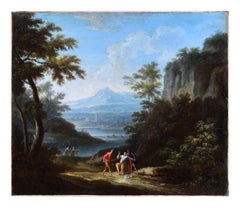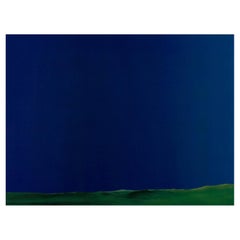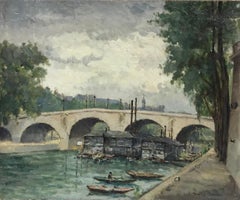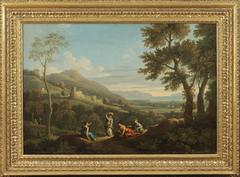Jan Frans van Bloemen (Orizzonte) Landscape Paintings
Flemish, 1662-1749
Jan Frans van Bloemen (baptized 12 May 1662 - buried 13 June 1749) was a Flemish landscape painter mainly active in Rome. Here he was able to establish himself as the leading painter of views (vedute) of the Roman countryside depicted in the aesthetic of the classical landscape tradition. Van Bloemen predominantly painted classical landscapes, taking his inspiration from the Roman Campagna. His landscapes, with their recession through a series of planes, soft, warm lightning and classical and religious subject matter, drew on the examples of artists such as Claude Lorrain and Gaspard Dughet. His paintings are exquisitely imbued with that "difficult-to-define pastoral ambience" which helped to make him such a great painter in the eyes of his contemporaries. The technique and subjects of the work of Jan Frans van Bloemen are also related to painters such as Jan Asselijn, Thomas Wyck, Willem Romeyn and Willem Schellinks. His painted vedute fall into the category of the vedute that combine reality with imaginary elements. His landscapes have an Arcadian lushness, with mountains, streams, distant hamlets, and small inhabitants painted with imprecise pittura di tocco ('painting of touch') using small dotting and spirited brush-strokes. Unlike van Wittel, van Bloemen did not generally depict views of areas distant from Rome such as the Tiber valley or the Alban hills. His subjects were limited to views in the immediate vicinity of Rome, an outline of which was typically visible in his compositions. Van Bloemen was in particular known for his 'estate views' representing the estates of the nobility in the Roman Campagna. His views aim to associate the modern estate view with the classical arcadian landscape. Rather than offering the wide panoramic views, distant horizon and atmospheric effects associated with topographical landscapes, van Bloemen's estate views emphasize minute observation of reality and a limited viewpoint. The estates are thus made to appear as immutable features of the local landscape. He worked together with other painters who painted the figures in his landscapes such as Carlo Maratti, Placido Costanzi and Pompeo Batoni. However, he only relied on such collaboration with figure painters in the last decades of his life when he produced his most ambitious classicising compositions. Even then he only relied on these figure specialists for the most prominent figures in the foreground while he took care of the minor characters. In fact, van Bloemen was an accomplished staffage painter and he was very skilled at quickly learning to imitate the style of his collaborators. As a result, many of the figures in his paintings that are attributed to prestigious contemporaries were actually by his own hand. His landscape drawings, which often depict imaginary ruins, have been confused with those of his brother Pieter, who is better known for his drawings of figures and animals. Jan Frans van Bloemen also made pen drawings of buildings in and around Rome.to
1
1
1
Overall Width
to
Overall Height
to
3
3
2
3
3
3
3
2
2
7
669
600
314
229
1
1
2
Artist: Jan Frans van Bloemen (Orizzonte)
Two Arcadic Landscapes - J.F. Van Bloemen (follower of) - Oil on Canvas
By Jan Frans van Bloemen (Orizzonte)
Located in Roma, IT
Two Arcadic Landscapes are a couple of original oil paintings by a follower of the Flemish artist, Jan Frans Van Bloemen (1662-1749).
These old master's original paintings represen...
Category
Early 18th Century Old Masters Jan Frans van Bloemen (Orizzonte) Landscape Paintings
Materials
Oil
Wooden Landscape with Shepherds, Fountain and Flock - by Jan Frans van Bloemen
By Jan Frans van Bloemen (Orizzonte)
Located in Roma, IT
Bibliography:
A.Busiri Vici, Jan Frans Van Bloemen Orizzonte e l’origine del paesaggio romano settecentesco, Ugo Bozzi Editore, Roma 1974, n.41
This artwork is shipped from Italy. U...
Category
18th Century Old Masters Jan Frans van Bloemen (Orizzonte) Landscape Paintings
Materials
Canvas, Oil
Pair of Roman Landscapes - by J.F. Van Bloemen - 18th Century
By Jan Frans van Bloemen (Orizzonte)
Located in Roma, IT
Beautiful couple of Roman Landscape by J. F. Van Bloemen, in very good conditions and with later wooden frames.
Bibliography and Exhibitions:
Old Master Exhibition, H.Terry-Engell, ...
Category
Early 18th Century Jan Frans van Bloemen (Orizzonte) Landscape Paintings
Materials
Oil, Canvas
Related Items
Chroma sky (Blue key) 10 - Contemporary, Blue, Minimalist, Figurative, Landscape
By Cătălin Petrișor
Located in Baden-Baden, DE
Chroma sky (Blue key) 10, 2007
Acrylic and oil on canvas
(Signed on reverse)
23.62 H x 31.49 W in
60 H x 80 W cm
The artist wrote about how he conceives this work:
"The transformat...
Category
Early 2000s Photorealist Jan Frans van Bloemen (Orizzonte) Landscape Paintings
Materials
Canvas, Oil, Acrylic
$1,505
H 23.63 in W 31.5 in D 0.79 in
Le Pont Marie, Paris Skyline over the River Seine, vintage oil painting
Located in Cirencester, Gloucestershire
Artist/ School: by Lucien Chanterelle (French b. 1890)
Title: Le Pont Marie, Paris. A beautiful Impressionist oil painting from the 1930's p...
Category
Early 20th Century Impressionist Jan Frans van Bloemen (Orizzonte) Landscape Paintings
Materials
Oil, Canvas
Lucien ChanterelleLe Pont Marie, Paris Skyline over the River Seine, vintage oil painting, c. 1930's
$1,323 Sale Price
20% Off
H 15 in Dm 18 in
Figures Chatting outside Village Tavern in Mountain Landscape, Period Oil
By 19th century Dutch or Flemish school
Located in Cirencester, Gloucestershire
Dutch/ Flemish School, early 1800's
oil on canvas, framed
framed: 19 x 24 inches
canvas: 13.5 x 18.5 inches
provenance: private collection, France
condition: good and sound condition...
Category
Early 19th Century Old Masters Jan Frans van Bloemen (Orizzonte) Landscape Paintings
Materials
Oil, Canvas
$1,428 Sale Price
20% Off
H 19 in W 24 in
Fine 17th Century Dutch Old Master Oil Military Encampment Figures on Horseback
By Philips Wouwerman
Located in Cirencester, Gloucestershire
The Military Encampment
Dutch School, 17th century
circle of Philips Wouwermans (Dutch 1619-1668)
oil painting on canvas, in 18th century gilt frame
canvas measures: 19.5 x 17 inches...
Category
17th Century Old Masters Jan Frans van Bloemen (Orizzonte) Landscape Paintings
Materials
Oil, Canvas
$4,356 Sale Price
20% Off
H 27 in W 24 in D 2 in
20th French Post Impressionist Oil Busy Summer Beach Scene Many Figures & Color
By Josine Vignon
Located in Cirencester, Gloucestershire
Sur la Plage
by Josine Vignon (French 1922-2022)
signed lower right
oil painting on canvas, unframed
canvas: 20 x 25.5 inches
Colors: Yellow gold and warm colors, red, blue and ora...
Category
Mid-20th Century Post-Impressionist Jan Frans van Bloemen (Orizzonte) Landscape Paintings
Materials
Canvas, Oil
Josine Vignon20th French Post Impressionist Oil Busy Summer Beach Scene Many Figures & Color, 1960's
$2,646 Sale Price
20% Off
H 20 in W 25.5 in D 1 in
Mother & Daughter Walking Coastal Pathway, Antique English Oil Painting
Located in Cirencester, Gloucestershire
Artist/ School: British School, late 19th/ early 20th century
Title: Mother & Daughter walking along the coastal path, with the sea beside them.
Medium: oil painting on canvas, f...
Category
Late 19th Century Victorian Jan Frans van Bloemen (Orizzonte) Landscape Paintings
Materials
Oil, Canvas
$1,488 Sale Price
20% Off
H 19.5 in W 27.5 in D 1 in
Large 17th century Italian old master - Noli me tangere, Christ in the garden
By Pier Francesco Cittadini
Located in Aartselaar, BE
Large 17th Century Italian Old Master, The Garden - Noli me tangere, Pier Francesco Cittadini (attr.)
Description
In the stillness of a garden in bloom, Noli me tangere captures a p...
Category
17th Century Old Masters Jan Frans van Bloemen (Orizzonte) Landscape Paintings
Materials
Canvas, Oil
$10,717
H 31.89 in W 40.56 in
Antique English Grand Tour Old Master Oil Figures Classical Arcadian Landscape
Located in Cirencester, Gloucestershire
Classical Landscape
English School, early 19th century, unsigned
oil on canvas, framed
framed: 29 x 37 inches
canvas : 19 x 27 inches
Provenance: private collection, UK
Condition: th...
Category
Early 19th Century Old Masters Jan Frans van Bloemen (Orizzonte) Landscape Paintings
Materials
Oil, Canvas
$2,702 Sale Price
20% Off
H 29 in W 37 in
Figures in Winter Dutch Snow Landscape Large 19th Century Oil on Canvas Painting
Located in Cirencester, Gloucestershire
The Winter Landscape
Dutch School, 19th century
oil painting on canvas, framed
framed: 22 x 28 inches
canvas: 16.5 x 23 inches
provenance: private collection, UK
condition: very goo...
Category
19th Century Old Masters Jan Frans van Bloemen (Orizzonte) Landscape Paintings
Materials
Oil, Canvas
$1,764 Sale Price
20% Off
H 22 in W 28 in
Landscape Near Felday, Surrey
By Abraham Hulk the Younger
Located in Hillsborough, NC
Dutch/English artist Abraham Hulk the Younger (1851-1922) is most known for landscapes of the British countryside. This work is one of a pair (the second work is also available by s...
Category
Late 19th Century Old Masters Jan Frans van Bloemen (Orizzonte) Landscape Paintings
Materials
Canvas, Oil
$2,240 Sale Price
20% Off
H 27 in W 22.75 in D 2.13 in
Huge 1800's English Oil Painting Man with Horses Resting Panoramic Country View
By Thomas Barker of Bath
Located in Cirencester, Gloucestershire
Pausing for a Rest
English School, circa 1800
the painting is very close to the works of Thomas Barker of Bath (English 1769-1847)
oil on canvas, framed
framed: 29 x 39 inches
canvas...
Category
Early 19th Century Old Masters Jan Frans van Bloemen (Orizzonte) Landscape Paintings
Materials
Oil, Canvas
$2,691 Sale Price
20% Off
H 29 in W 39 in D 1 in
17th century Flemish seascape - Stormy Sea with Merchant Vessels and dolphins
By Bonaventura Peeters the Elder
Located in Aartselaar, BE
Bonaventura Peeters the Elder (1614–1652) attr., Stormy Coastal Scene with Merchant Vessels, Galliot, and Dolphins
Framed by rugged cliffs and illuminated under a dark, swirling sk...
Category
17th Century Old Masters Jan Frans van Bloemen (Orizzonte) Landscape Paintings
Materials
Oil, Panel
$7,827
H 16.15 in W 27.76 in
Previously Available Items
Landscape with Arcadian Figures
By Jan Frans van Bloemen (Orizzonte)
Located in New York, NY
Provenance:
Purchased in Belgium, 1950s (as by Poussin)
Private collection, 1950s to present
Orizzonte is best known for his Italian countryside scenes, but his early training...
Category
17th Century Old Masters Jan Frans van Bloemen (Orizzonte) Landscape Paintings
Materials
Acrylic Polymer, Canvas, Oil
Landscape with Arcadian Figures
By Jan Frans van Bloemen (Orizzonte)
Located in New York, NY
Jan Frans van Bloemen, called Orizzonte.
Orizzonte is best known for his Italian countryside scenes, but his early training was in Flemish landscape painting. While still fairly ...
Category
18th Century and Earlier Jan Frans van Bloemen (Orizzonte) Landscape Paintings
Materials
Oil, Canvas
Jan Frans Van Bloemen (orizzonte) landscape paintings for sale on 1stDibs.
Find a wide variety of authentic Jan Frans van Bloemen (Orizzonte) landscape paintings available for sale on 1stDibs. You can also browse by medium to find art by Jan Frans van Bloemen (Orizzonte) in oil paint, paint, canvas and more. Much of the original work by this artist or collective was created during the 18th century and is mostly associated with the Old Masters style. Not every interior allows for large Jan Frans van Bloemen (Orizzonte) landscape paintings, so small editions measuring 22 inches across are available. Jan Frans van Bloemen (Orizzonte) landscape paintings prices can differ depending upon medium, time period and other attributes. On 1stDibs, the price for these items starts at $18,382 and tops out at $54,589, while the average work can sell for $49,018.






